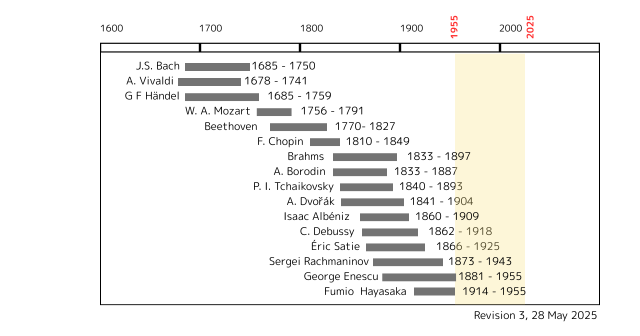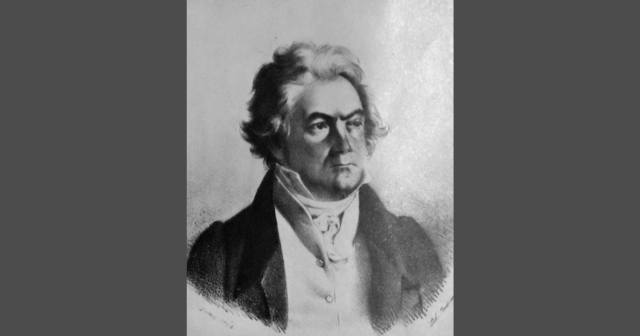The Symphony No. 9 in D minor, Op. 125, is a choral symphony, the final complete symphony by Ludwig van Beethoven, composed between 1822 and 1824. It was first performed in Vienna on 7 May 1824. The symphony is regarded by many critics and musicologists as a masterpiece of Western classical music and one of the supreme achievements in the history of music. One of the best-known works in common practice music, it stands as one of the most frequently performed symphonies in the world.
交響曲第9番ニ短調 作品125は、ルートヴィヒ・ヴァン・ベートーヴェンによる合唱付きの交響曲で、ベートーヴェンの最後の完結した交響曲。1822年から1824年にかけて作曲され、1824年5月7日にウィーンで初演された。
多くの批評家や音楽学者によって西洋クラシック音楽の傑作であり、音楽史における最高の業績の一つと見なされている。一般的な音楽の中で最もよく知られる作品の一つであり、世界で最も頻繁に演奏される交響曲のひとつ。

My first purchase of a classical music record was Beethoven’s “Ninth Symphony.” It was the early 1970s, and I was around 12 yo. At that time, not only were personal computers non-existent, but CDs had also not yet become widespread. For ordinary people, the only ways to experience serious music were either to attend a concert—often beyond reach—or to place a needle on an LP record.
Unfortunately, I no longer have that LP, but I distinctly remember it being performed by the Berlin Philharmonic under the direction of Karl Böhm. Every movement left a strong impression on me, but I was especially captivated by the whimsical and dramatic expression of the second movement, the Scherzo. It wasn’t until I studied music theory and examined the score years later that I realized the theme of this movement was written in triple meter.
Later, I decided to transcribe this piece into MuseScore. This endeavor was like assembling a massive Tamiya model of the battleship Yamato. Each instrument’s part seemed like a collection of meaningless melodies, but when combined, they transformed into a powerful, expressive work. Some sections resembled integrated circuits, densely packed with notes. I once thought that with so many notes, a single mistake would go unnoticed. However, in reality, even one incorrect note created a sense of dissonance that was unbearable to listen to.
I focused solely on the second movement, omitting all repetitions, and transcribed it from beginning to end. After three months of adjusting the balance, I became overwhelmed by the sheer volume of work and temporarily abandoned the project. Yet, half a year later, I regained my motivation, and finally, I completed the second movement, spanning 80 pages in MuseScore.
There seems to be an infinite distance between an ordinary person and a genius.
私が初めてクラシック音楽のレコードを購入したのは、ベートーヴェンの「第九」でした。当時は1970年初頭で、私は12歳かそこら。パソコンはおろかCDも普及しておらず、一般の人々が本格的な音楽を楽しむ方法は、コンサートに足を運ぶか、LPレコードに針を落として聴くことでした。
そのLPは残念ながら手放してしまいましたが、確かカール・ベーム指揮のベルリン・フィルハーモニー管弦楽団の演奏だったと記憶しています。どの楽章も強い印象を残しましたが、特に第二楽章のスケルツォは、その奇想天外な表現で私を圧倒しました。後に楽典を学び、スコアを確認するまで、この楽章のテーマが三拍子で書かれていることに全く気づいていませんでした。
その後、私はこの曲をMuseScoreで打ち込むことに挑戦しました。これを例えるなら、タミヤの巨大な戦艦大和のプラモデルを組み立てるような作業でした。一見すると意味のない旋律が各パートに散らばっていますが、それらが組み合わさることで深い表現が生まれます。ある部分は集積回路のように音符が密集し、音の洪水を成していました。「これだけ音が多ければ、一つぐらいミスがあっても気づかれないだろう」と考えたこともありましたが、実際には一つでも原典と異なる音があると、違和感が耳に残り、聴きづらいものになりました。
第二楽章だけを対象にし、全ての繰り返しを省いて冒頭から終わりまで打ち込みました。バランスを整えながら作業を進めるうちに3ヶ月が経過し、一時はその膨大な作業量に挫けてしまいました。しかし、半年後に再び意欲を取り戻し、ついにMuseScore上で80ページに及ぶ第二楽章を完成させることができました。凡人と天才の間には無限とも思える距離があるようです。

コメント